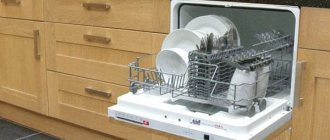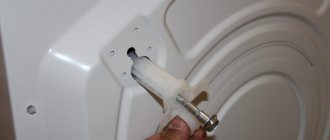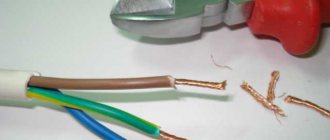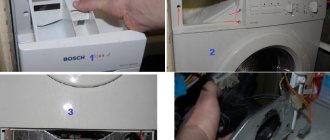What to look for when choosing dishwashing equipment
The advantages of a built-in dishwasher over a free-standing one are that it significantly saves kitchen space and fits harmoniously into the finished design. All you have to do is decide what size machine you need and correlate the dimensions of the equipment with the location of its intended location.
Types of Dishwashers
First of all, all dishwashers can be divided into household and industrial. The latter are used in public catering places and enterprises, so we will not touch on them.
Household dishwashers can be divided into the following types:
- fully built-in - the system is completely hidden behind the furniture facade. The control unit is located at the end of the front wall. Such models are often equipped with an indicator beam. It creates a light marker on the floor surface, which signals that the washing cycle is not completed;
- partially built-in - the front wall is completely open or partially hidden behind the furniture front. The control panel in this case is located above the facade and is accessible even when the machine is turned on;
- free-standing - an independent unit in its own housing; The following classification affects the dimensional characteristics of dishwashers. The machines are distinguished:
- full-size - with a width of 60 cm. An excellent option for a large family. This “helper” can handle a whole mountain of dishes. In one cycle it can wash from 10 to 17 sets. It is easy to place pots and baking trays in it. The height of such machines ranges from 82-87 cm, depth 55-60 cm. They are presented in all categories - built-in, partially built-in, separate;
- narrow - their width can be from 45-49 cm. They can accommodate a maximum of 10 sets of dishes. More suitable for small families of 3-5 people. If the family is large, you will have to run it several times;
- compact - small devices similar in size to a microwave oven. They have a width of 35-45 cm, so they are easy to place in any, even the smallest kitchen. They can wash 4-6 sets of dishes per cycle. Available in built-in and free-standing design options.
Choosing a size
Built-in dishwashers come in several sizes, and, accordingly, can accommodate different amounts of dishes.
Table 1. Dimensions of dishwashers
SizeDimensions in centimetersMaximum capacity (in the number of cookware sets)
| Mini | 50/50/55 | 5 |
| Narrow | 45/55/85 | 8 |
| Full size | 60/60/85 | 17 |
Please note: different equipment manufacturers may vary in size by up to 5 cm.
How to plan the installation of installations of various sizes, drawing
Mini dishwashers are convenient because they can be built into a small kitchen, even under a sink or in a pencil case, since it is similar in size to a microwave oven and its location at eye level is quite convenient. Narrow units should only be purchased if you do not have a large family. It is advisable to choose full-size ones if you have a lot of relatives and the house is full of guests. But, you need to understand that such a machine will take up more space in the kitchen.
There are different types of machines, the body dimensions of which may vary.
Energy efficiency classes and labeling
Electricity consumption and energy efficiency are also important points to pay attention to when purchasing. Manufacturers are required to indicate the energy efficiency class for each product.
As a rule, it is indicated on a sticker that is pasted on the device itself or placed in a package with documents for the equipment. Classes are marked with Latin letters: A+++, A++, A+, A, B, C, D (until 2010, the markings were indicated by the letters A, B, C, D, E, F, G), where, respectively, class A +++ – the most economical model in terms of electricity and water consumption.
How energy efficiency classes are marked for various types of dishwashers
But the price for such models will be significantly higher than for a product with a subsequent gradation of classes. The sticker should also indicate:
- product model and brand;
- water consumption in liters per cycle;
- electricity consumption per cycle (kWh);
- drying class (A - G);
- number of sets of dishes;
- class of noise produced in decibels.
Explanation of the symbols found on the sticker that is equipped with the dishwasher body
How to install a dishwasher
The dishwasher can be installed in different ways. Any of them is associated with certain problems during installation, but by following the recommendations and requirements of the manufacturer specified in the technical data sheet, you can avoid all problems. Let's look at the most common and most acceptable installation options below.
It is important to decide what size machine you need and correlate the dimensions of the equipment with its intended location.
Cabinet installation
Installing a dishwasher in a finished kitchen is carried out in the following order.
- In the selected furniture block, it is necessary to dismantle the internal filling and the back covering. Depending on the model of the dishwasher, it may be necessary to remove the bottom panel of the furniture unit.
- After this, adjusting the legs on the body of the device, it must be installed vertically, for which use a building level.
- Next, connect the dishwasher to the drain, supply cold water and connect the power supply. If necessary, it is possible to install a water seal on the drain.
- The front panel is attached last. You can assemble it yourself from the removed doors of a furniture block, or contact a specialized workshop for custom manufacturing.
If you decide to integrate the appliances into the kitchen unit, you need to measure the cabinets and determine which of them is most optimal for installing a dishwasher.
There are partially built-in models of dishwashers. In this case, no front panel installation is required, simplifying the installation process.
Hoses can be integrated into a system installed under the sink using adapter fittings.
Installation in a free-standing module
If the kitchen area is large enough and you do not have suitable cabinets, then you can consider the option of installing a free-standing furniture module. In this case, you need to contact the furniture company to order the appropriate cabinet. It is best to place it near the sink for access to communications.
Connect the sewer and water by laying hoses along the wall. Turn on the electricity. After this, it is necessary to secure the dishwasher so that during operation it does not move its new module due to vibrations. At the last stage, secure the front panel of the furniture module if necessary.
If there is no suitable cabinet in the set, and the kitchen space allows, you can order a separate cabinet for the car.
Niche installation
If your kitchen set has a designated place in the form of a niche for placing a microwave or oven, then you can also install a dishwasher in this place. For such niches, special compact models are offered on the market. However, if such a place is located far from the sink, then you will have to lay hoses for supplying cold water and discharging used water.
The front part of such a machine can also be covered with a decorative facade in the general style of the kitchen. Although such a small machine requires little space, its performance is also low, so this option is not suitable for a large family.
The compact built-in dishwasher can be installed in a niche provided for an oven or microwave.
Installing a built-in dishwasher
The dishwasher is placed in the kitchen cabinet. The main thing is to choose a place near sockets or sewers so that there are no connection problems in the future.
A small dishwasher is built into a niche intended for an oven or microwave. To make it look harmonious with other elements of the kitchen interior, the door is decorated in the same style as the facade. A wooden facade is also worth taking care of. For example, oil-wax for wood, information about which can be found here, has a wide range of applications: it gives wood water-repellent and bioprotective qualities. properties, prevents the effects of UV rays, gives any desired noble shade.
Features of embedding PMM
If you want to maintain a single “picture” of the kitchen without separating the furniture to install appliances, then a built-in model is perfect. Such a dishwasher will hide behind the outer façade, without revealing itself in any way.
The choice of built-in PMMs today is especially large. Among them are the following brands: Bosch, Gorenie, Electrolux, Zanussi, Kandy, Veko and others. They differ not only in functionality, but also in size:
- full-size models are produced with a width of 60 cm, a height of 80 cm, and a depth of 45 cm;
- Compact PMMs measure 45 cm in both width and height.
It is better to integrate such dishwashers into a new kitchen unit, where there is space for them. Usually this is a larger box than the car, because it should not stand close to the walls. Be sure to leave space for ventilation - at least 5 cm. The back wall of the cabinet may be absent or have holes for hoses.
Installing built-in PMMs yourself is quite simple. The kit includes templates with markings for fastenings for hanging the decorative panel.
If you have to start from furniture that is already in the kitchen, choose a place near communications. The ideal option is to the right or left of the sink. Empty the suitable cabinet from the shelves and remove the door. Integration under the countertop is convenient if the machine is equipped with wheeled legs that are height-adjustable.
It is not advisable to place the dishwasher near stoves, ovens or heating appliances.
When purchasing equipment, a warranty is issued, which is void if connected incorrectly. For example, the use of tees or carries is prohibited. You cannot connect the PMM to a stove socket. The cord of the machine is quite short, so the socket should be located at a height of 45 cm from the floor, and also have a European standard, grounding, and connection through a difavtomat.
Installing a Freestanding Undercounter Dishwasher
This is the most convenient way to embed a dishwasher into an already installed kitchen set. Use it if you have a cabinet that is slightly larger in size than your typewriter - and it is located no more than 1.5 meters from the communication nodes.
First, completely dismantle the old compartment: remove not only the shelves and fastenings, but also the walls, including the back, and the base. Then connect the drain and inlet hoses: the first is connected to one of the siphon outlets, the second - through the installed tee to the pipe.
The tabletop will be protected from swelling under the influence of steam by a metal sheet that covers its lower part. You can also use insulating film instead, but it will not be as reliable. Different manufacturers have different approaches to solving this issue. You can choose your preferred method of protection yourself and arrange it yourself.
Whether or not to decorate a decorative facade is a question that remains entirely at your discretion. In addition, there are different dishwashers, and there are models that look good in the room without any cosmetic frills.
Dishwasher installation conditions
Before deciding to purchase a dishwasher, decide on the location and possibility of installing it.
This task is much easier to solve with free-standing modifications. They will require very little free space on any of the countertops of the kitchen work area, on the windowsill and even on the floor. The built-in model is installed only in a specially prepared niche.
The undeniable advantage of built-in models is their high hygiene, reduced noise level, and lack of visibility of the unit body, hoses and wires . All this makes such dishwashers more preferable. It is ideal to use kitchen units with a ready-made cabinet for installing a dishwasher. Otherwise, you will have to provide a suitable place yourself.
To do this, you first need to find out the exact dimensions of the main models offered by trading enterprises. Such information is presented in advertising brochures and prospectuses, on store websites, or on price tags in the sales area.
Next, using a tape measure, take measurements of all cabinets and other pieces of furniture in the kitchen. Take into account any free space, for example between cabinets, between a cabinet and a refrigerator, and so on. Based on the results of these studies, a car model is selected based on its dimensions.
Dishwashers from well-known manufacturers often have a width of 60 cm and less often 45 cm (narrow models). Narrow models have a height of 82 to 88 cm, which corresponds to the standard height of kitchen tables. The depth of all machines is 55 cm , which makes it possible to connect communications to fittings and connectors located on the rear wall.
The presence of free communication connection points or the possibility of parallel input is taken into account at the next stage of preparing the installation site.
To connect you will need:
- cold water pipes;
- sewer pipe;
- electrical outlet with a grounding terminal.
If the electrical cable, if necessary, is supplied without much effort, then with water supply and drainage pipes it is already more difficult. For this reason, the installation location is chosen next to the sink. The ability to equip risers with tee fittings will solve the connection problem quickly and at minimal cost.
How to install a dishwasher in the kitchen
There are two options for installing the PMM: in a finished kitchen or in a pre-designated place in the kitchen unit. Dishwashers vary in type and size:
- Compact. Holds from 3 to 5 sets of dishes. Dimensions 50x60x50 cm. Installed on the countertop or under the sink.
- Narrow. Width 45 cm, capacity from 6 to 10 sets. Can be fully or partially built-in.
- Full size. Dimensions 65x65x90 cm, holds from 10 to 15 sets of dishes. Can be built-in or free-standing.
Typically, manufacturers provide space for placing equipment in any kitchen set. To do this, take the dimensions of a narrow dishwasher and add 5-10 cm to them on all sides. If your kit does not include a special cabinet, then it is better to choose a freestanding machine. You can install it in any convenient place, even between the cabinets.
When choosing a freestanding PMM, you need to take into account that the appearance of the cabinet is combined with the design of the kitchen.
By the way, for connoisseurs of beautiful, eco-friendly and high-status furniture, there are ready-made antique interiors using natural wood, created according to your own original designs. If you have prepared drawings in advance for placing a Samsung, Miele or other brand dishwasher, there will be no problems with installation. Otherwise, for embedding, select a cabinet close to the sink. Please note that the distance from the PMM body to the rear wall must be at least 5 cm for normal ventilation.
If you have a small family and the kitchen area does not allow you to install a full-size model, choose a tabletop option. You can put it under the sink, and the connection rules do not differ from other models.
Installation steps
The issue of installing a PMM, that is, a dishwasher, should be approached with the utmost responsibility. This is a serious task that not everyone can handle.
The entire procedure can be roughly divided into several successive stages. The work consists of:
Useful tips when choosing and installing PMM
- Before purchasing built-in appliances, measure the dimensions of your kitchen cabinet.
- The legs of the dishwasher can be adjusted in height. Use a level to position the machine level. Some Hotpoint Ariston and Whirlpool models are very sensitive to a tilt of even 2 degrees. This may affect their future work.
- Mount the machine near a sink. This will make it easier to connect the drain and water without having to extend the hoses. Experts say that extending the hoses can lead to leakage and will also put more strain on the drain pump.
- When built into furniture, install a metal plate under the tabletop to protect the wood from steam. In built-in models, the plate is included.
Please refer to the instruction manual. It shows the procedure for installing and installing the dishwasher. The kit includes templates for hanging the door.
- To connect equipment to the network, a separate moisture-resistant socket is used. Do not connect via extension cords or tees.
Communications for connection
The machine requires three external sources to operate:
- electricity - must come from the electrical network of the house to the outlet closest to the car;
- clean cold water - there should be a water pipe nearby with a threaded connection;
- Sewage system - to drain dirty water, there must be sewer pipes nearby with the possibility of connecting an additional drain point.
Choosing a place
When deciding how to install a dishwasher, it is necessary to comply with the main installation condition - ensuring free access to all communications. In this case, the electrical outlet, water pipe (preferably with a faucet for connection) and the sewer drain pipe should be located as close to the machine as possible. In almost every kitchen, this condition is satisfied by a place in the cabinet near the sink.
Conduct the communications necessary for functioning in advance
Kitchen cabinet remodel
There are two options here - a free-standing cabinet or built into a common kitchen countertop. Before installing a dishwasher, let's assume that the dishwasher exactly fits the width and height of the cabinet, so alterations should be minimal.
Conditions for installing a dishwasher in the kitchen
The main condition is the availability of free space for the installation of such fairly large equipment. Especially important for modest-sized kitchens. And if with free-standing appliances everything is simple - it can be installed on almost any area of 0.6x0.6 m, then with built-in models you will have to think a lot about which compartment of the kitchen unit is best sacrificed in order to organize integration.
So pick up a tape measure and take measurements. If you already have some dishwasher models in mind, compare the data received with their dimensions - and draw very specific conclusions about whether this or that solution is suitable for you or not.
Other conditions for installing PMM in a finished kitchen:
- the presence of all communication nodes (sewage, water supply, electricity) within meter (maximum 1.5 m) accessibility;
- allocation of a separate 220V power line with mandatory grounding and a waterproof socket;
- convenience of location (don’t forget about the working triangle rule);
- a distance of at least 40 cm from the hob, radiator and other heat sources;
- cannot be placed close to the washing machine;
- Do not place the microwave oven on a compartment with a dishwasher installed - electromagnetic waves negatively affect the electronic components of the dishwasher.
Finally, one more point is the connection to the water supply. Contrary to popular belief, it is not necessary to connect the machine to hot water. Moreover, without protective filters that regulate the temperature, it may even fail over time, so a cold water source is sufficient.
Possible embedding options
Manufacturers produce PMM models with standard parameters:
- height 815-875 mm;
- width 598 and 448 mm;
- depth 550 mm.
The range of dimensions allows for the use of several installation options. The control elements of the devices are located at the end of the door, and the legs can be adjusted in height. For a tight fit, the equipment is equipped with corner fasteners and self-tapping screws.
When installing it yourself, it is important to take into account the parameters of the kitchen unit, the presence of water supply and sewerage communications, as well as a free line with an outlet.
Advice! Install the machine next to the sink, where there is access to the main water supply and drainage units.
Cabinet installation
If there are cabinets more than 45 cm wide next to the sink, you can disguise household appliances. Installing a built-in compact dishwasher in a cabinet will allow you to connect the drainage and water intake pipes to ready-made communications. The work includes:
- removal of shelves, bottom panel and back wall from the cabinet;
- vertical adjustment of the PMM body using legs;
- connecting an extended pipe with a shut-off valve for cold water;
- laying a drainage pipe into a siphon;
- organization of an additional outlet;
- installation of a decorative front panel on the device door.
With a front panel on the device door Important! If necessary, a water seal with a drain pipe is installed.
Installation in a free-standing module
The method is relevant if the furniture set does not have suitable cabinets, but the kitchen area is spacious. Order a separate cabinet for a compact machine and install it next to communications. Connection consists of the following operations:
- aligning and securing equipment so that it does not move during operation;
- laying hoses and pipes along the walls for ease of access.
Important! The location of the PMM in a separate module eliminates the difficulty of dismantling if the hose breaks.
Niche installation
The presence in the kitchen set of a special niche for a microwave, oven or compact equipment solves the question of how best to integrate a household dishwasher into a ready-made, assembled kitchen.
Separating the niche from communication networks involves the use of long flexible hoses for supplying water and drains. The front part of the machine is covered with a cover for the facades.
Built into a niche Important! Compact dishwashers are suitable for a family of 2-3 people.
If embedding is not suitable
In small rooms it is advisable to install free-standing devices. What is the best way to install a small household dishwasher, experts say:
- place on the table if the dishwasher is no larger than the oven;
- place in an open module;
- place under the sink;
- allocate a small area for narrow models.
Connection to communications is carried out only after installation of the equipment is completed.
Advice! If there is no room for a built-in device, remodel the kitchen unit, move the lines, but be prepared for large financial costs.
Preparation of tools and materials
No special tools are required to secure the façade trim.
The same items that are used to install the dishwasher as a whole will be useful:
- drill;
- screwdriver;
- awl;
- screwdriver;
- tape measure or ruler;
- pencil or marker.
If you don’t have a power tool, then one screwdriver is enough - you can screw in the screws by hand if the holes for them are pre-drilled.
The drill bit is selected according to the diameter of the screws: the holes should be a little tighter so that the fasteners are held firmly in the sockets
The work is simplified by the presence of a stencil for the façade overlay included in the delivery set. It is a large sheet of thin paper with marked attachment points.
The stencil is placed on the back side of the decorative panel and the places where the screws are screwed in are marked.
In addition to the tools, you will need double tape. Several “Velcro” pieces of tape will come in handy when you need to try on the facade. It is not recommended to immediately “mount” it on screws, since an error of 2-3 millimeters will mean all the work is in vain.
Don’t forget about the handle, without which opening the door will be problematic. It is also fixed with self-tapping screws, which are screwed into the back of the panel.
To ensure that the surfaces of the door and facade adjoin as tightly as possible, the heads of the screws should be recessed into the canvas.
It is easier to attach the workpiece than a homemade overlay. If you make the panel yourself, you may need carpentry tools, sandpaper for sanding, antiseptic impregnation and paint to finish the entire surface or just the ends.
Read more: Heating cable for sewer pipes











